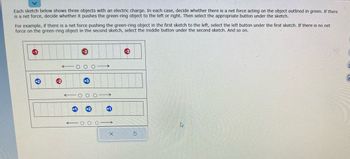Question

Transcribed Image Text:Each sketch below shows three objects with an electric charge. In each case, decide whether there is a net force acting on the object outlined in green. If there
is a net force, decide whether it pushes the green-ring object to the left or right. Then select the appropriate button under the sketch.
For example, if there is a net force pushing the green-ring object in the first sketch to the left, select the left button under the first sketch. If there is no net
force on the green-ring object in the second sketch, select the middle button under the second sketch. And so on.
N
X
h
Expert Solution
This question has been solved!
Explore an expertly crafted, step-by-step solution for a thorough understanding of key concepts.
Step by stepSolved in 4 steps with 8 images

Knowledge Booster
Similar questions
- For problems 6-11, make sure to include pictures, Free Body Diagrams, and force charts. 6. What is the magnitude of the net electric force on charge A in the figure to the right? = Assume that q₁ = 1.5 nC and 9₂ What is the direction of the net 4.8 nC. electric force on charge A? Answer: F= 4.1×10¯5 N to the right A 9₁ A + 1 cm B -9₁ 1 cm 92 C(+arrow_forwardUnderstanding how electrostatic forces cancel Each sketch below shows three objects with an electric charge. In each case, decide whether there is a net force acting on the object outlined in green. If there is a net force, decide whether it pushes the green-ring object to the left or right. Then select the appropriate button under the sketch. For example, if there is a net force pushing the green-ring object in the first sketch to the left, select the left button under the first sketch. If there is no net force on the green-ring object in the second sketch, select the middle button under the second sketch. And so on. Explanation +2 Check +3 +2 tv ♫ A [ 0 © 2023 McGraw Hill LLC. All Rights Reserved. Terms of Use | Privacy Center | Accessib Aarrow_forwardA small sphere with a mass of 0.450 gram is suspended by a non-conducting silk thread as shown. The sphere is subject to an electric field of 3000 N/C directed to the left and the sphere swings out 8° from the vertical as shown below. Follow the steps below to determine the magnitude of the charge on the sphere. A. e = 8° 1. Label all the forces acting on the small sphere on the diagram on the left. 2. Using the forces on your diagram determine the charge (magnitude and quality (+ or - )) on the ball.arrow_forward
- RELATIONSHIP OF ELECTRIC FORCE, ELECTRICAL CHARGE AND DISTANCE OF CHARGES. DIRECTION: Choose the correct term in the parenthesis 1. The magnitude of distance of charges is ( inversely proportional , directly proportional) to the electrical force. 2. If the charge of both particles is doubled, the force ( unchanged, halved, doubled, quadrupled) 3. If the charged of one of the particles id doubled, the force is ( unchanged, halved, doubled, quadrupled) 4. If the distance between the particles is doubled, the force becomes ( one fourth, half, double, 4 times) 5. The product of charges is ( inversely proportional , directly proportional) to the electrical force.arrow_forwardplease answer all parts of the question, if it says to explain, use wordsarrow_forwardPracticearrow_forward
- Each sketch below shows three objects with an electric charge. In each case, decide whether there is a net force acting on the object outlined in green. If there is a net force, decide whether it pushes the green-ring object to the left or right. Then select the appropriate button under the sketch. For example, if there is a net force pushing the green-ring object in the first sketch to the left, select the left button under the first sketch. If there is no net force on the green-ring object in the second sketch, select the middle button under the second sketch. And so on.arrow_forwardI need help on this nongraded review.arrow_forwardDerive the expression for the electric field in the rod, based on quantities (letters) shown in the diagram. (Show your work.) Then evaluate the expression to give a numerical answer with unit. Please see diagram for more details.arrow_forward
- Determine the magnitude of the electric field at A. Express your answer to two significant figures and include the appropriate units. Use Coulomb's law to determine the magnitude of the electric field at points A and B in (Figure 1) due to the two positive charges (Q = 5.1 µC) shown. Suppose that a = 5.1 cm Ti HÁ E, = Value Units Submit Request Answer Part B Determine the angle between the direction of the electric field at point A and the positive x-direction. Express your answer using two significant figures. nν ΑΣ φ. OA = 0.83 Submit Previous Answers Request Answer X Incorrect; Try Again; 5 attempts remaining Figure < 1 of 1 Part C В Determine the magnitude of the electric field at point B. Express your answer to two significant figures and include the appropriate units. +Q• +Q ? 2a EB = Value Units Submit Request Answer P Pearsonarrow_forwardShow complete processarrow_forward
arrow_back_ios
arrow_forward_ios